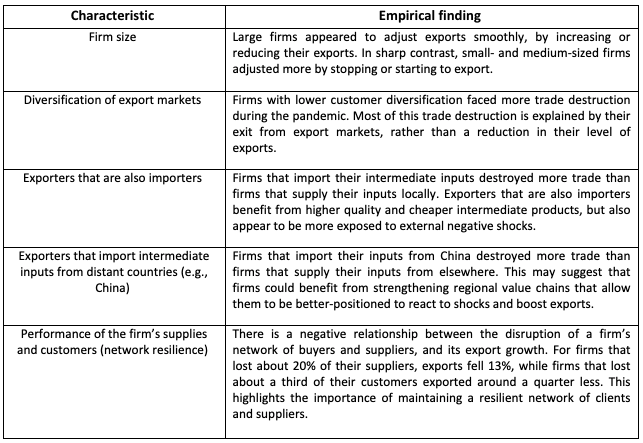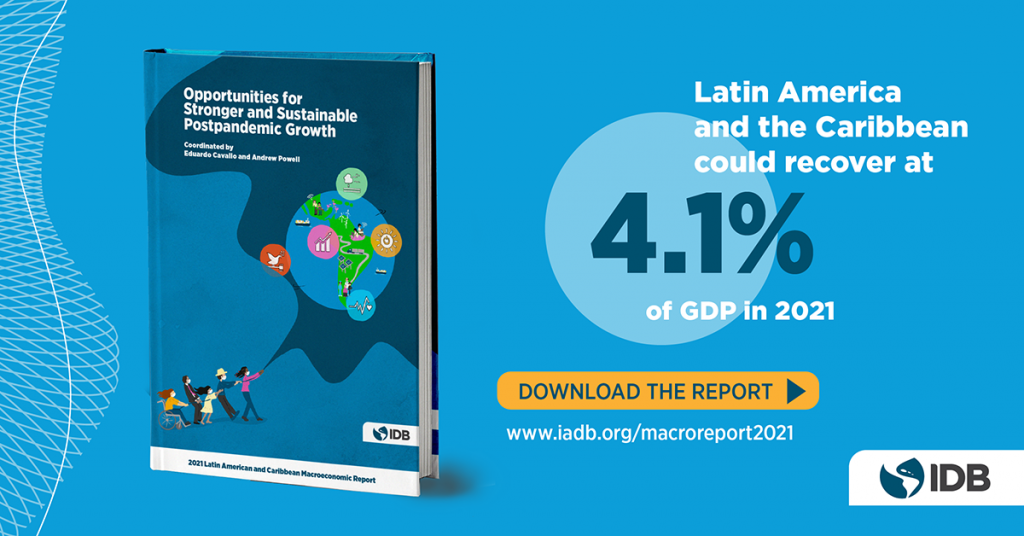
Global value chains (GVCs) are essential to modern trade. Given the separation of production into several stages, carried out in different countries, GVCs allow nations to increase productivity through specialization. Yet Latin America and the Caribbean’s participation in GVCs remains low (18%) compared to Asia (28%) and Europe (34%).
The paradox of the COVID-19 crisis, with its lockdowns and production disruptions, is that it has taken a huge toll on trade while providing Latin America and the Caribbean with new opportunities to increase its participation in GVCs. As companies around the world seek protection from disruptions by diversifying their supplier base, companies operating in the region could benefit by complementing or replacing some of foreign companies’ pre-COVID suppliers. The COVID-19 crisis could also represent an opportunity for the region and its exporters to increase their resilience to disruptions by deepening regional trade integration.
The question is what makes greater resilience and deeper participation in GVCs possible. To answer that question, the chapter on trade in the 2021 IDB Macroeconomic Report evaluates the performance of the region’s exporters during the COVID-19 pandemic. Understanding the characteristics behind firms’ performance allow us to draw policy implications that may be helpful in shaping the region’s economic recovery.
During the COVID-19 pandemic, total exports declined sharply in most countries of the region and across the majority of sectors and destinations. They not only declined (white and gray bars in Figure 1); they did so relative to a measure of global demand (solid and dash blue lines in Figure 1).
Figure 1. Aggregate Export Growth versus Global Demand Growth

Note: The dark blue bars correspond to the growth of total exports and the light blue bars correspond to the growth of intermediate inputs excluding those in mining and agriculture, following the Broad Economic Categories (BEC) classification. The green line shows the average export growth from first quarter 2018 to third quarter 2019. The yellow line shows the growth of foreign demand for intermediates only, while the purple line shows the growth of foreign total demand.
The Reallocation of US Imports Across Regions: Who Benefited the Most?
Take the case of the United States, the main destination for the region’s exports. During the COVID-19 crisis, US imports from the region fell by 16%, compared to an 18% drop of imports from China, the largest decline. Only Europe with a 2% increase, boosted its exports to the US (see Figure 2). In nominal terms, around US$56.5 billion (6.1%) of total US imports switched source countries during this period, twice the size of the cross-regional reallocation of US imports registered in “normal times.” This could represent a considerable opportunity for Latin America and the Caribbean, which exported US$26 billion in goods in 2019 to the United States.
Figure 2. Reallocating US Imports across Regions: Who Benefited the Most?

Note: The left panel of the figure shows the percent change in US imports from each of the selected regions. The right panel shows the change in market share of US imported intermediate inputs (in percentage points) from each region. The numbers on top of the bars show the market share of each region in 2019 (left) and in 2020 (right).
Unpacking Net Export Growth
How can the region emulate Europe or Asia (excluding China) and take greater advantage of firms’ reassessment of global value chains in the wake of COVID-19? During the pandemic period, exports in Latin America and the Caribbean declined in most sectors, but even within those sectors some exporting firms ‘created trade’ either by increasing their level of exports during the first three quarters of 2020 relative to 2019, or because some companies that did not export during this period in 2019 did so in 2020. At the same time some firms `destroyed trade’ by exporting less or by exiting the export market altogether in 2020. In the empirical analyses five firm characteristics appear to play a key role in explaining export performance during the pandemic (Table 1).
Table 1. Firm Characteristics and Relation with Export Growth during COVID-19

Policy Implications
Increasing participation in global value chains can help countries boost their productivity and growth but also intensify their vulnerability to shocks. But the right policies can simultaneously enhance participation and reduce risks. Some specific policies that could lead to this goal are:
Deepening regional value chains: A complicated “spaghetti bowl” of trade agreements that lacks consistent rules across the region, coupled with complex regulations that increase the costs of compliance, have significantly reduced trade. A bottom-up approach that ensures consistency in the rules of origin between the many different agreements, and the removal of non-trade barriers would boost intra-regional trade.
Small and medium enterprises as exporters (SMEs): Most exports are driven by a limited number of large firms, which are often multinational corporations. However, supply chains have become much more fragmented and dispersed with longer and wider-growing networks of small- and medium-sized (SMEs) upstream and downstream enterprises. Importantly, SMEs account for substantial trade creation and destruction, especially as new firms start to export and then soon drop out of the export market. Policies designed to help efficient firms cope with transitory negative shocks and thus avoid dropping out of the export market could be highly beneficial. That would include policies that lower regulatory costs for trade finance.
Exporters’ network resilience: Having a robust network of suppliers enhances the performance of export firms. It is critical to implement policies that enhance the ability of firms to connect with new suppliers and customers. Online networks that help SMEs connect to international markets are an important tool. One example is ConnectAmericas, an online network created by the IDB, with support from Google, DHL, Visa, and Alibaba, which seeks to promote international trade and investment for firms of all sizes in the Americas.
The COVID-19 pandemic, for all its tragedies and disruptions, could become an important opportunity for Latin America and the Caribbean as foreign markets modify their sourcing strategies. Policies that today promote credit for trade, help firms connect with the international market, and prevent clients and suppliers from being dropped from a firm’s network, may be more effective in allowing firms to seize opportunities than similar efforts in normal times. Turbulent times can lead to great gains when earlier and more sustained efforts promoting firms’ participation into GVCs are in place.



Very interesting analysis. So diversification and firm size is key to resilience.